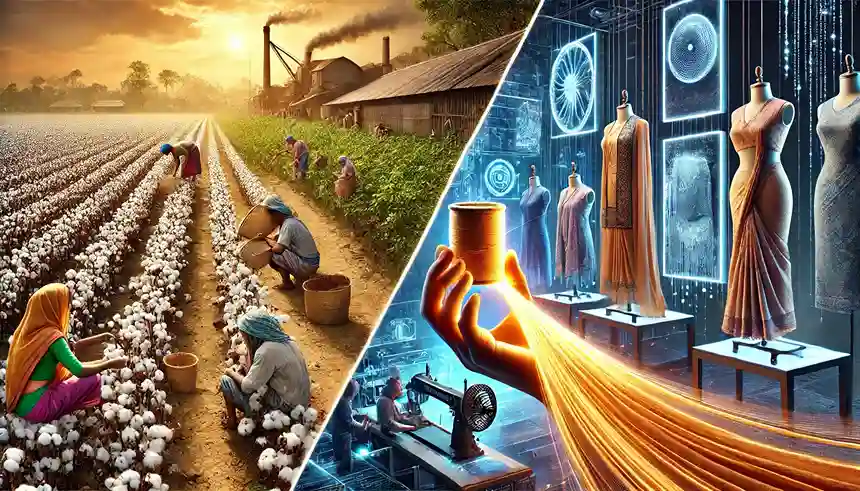Cotton—is a simple word, yet it holds the threads of an entire industry, especially in Bangladesh. As the world’s second-largest exporter of garments, Bangladesh is now facing a storm no one saw coming: the cotton crisis of 2024. This has caused a significant upset in the apparel industry as this shortage has tampered with the core and affected millions of employees.
However, what if this is the opportunity for the club to grow and strengthen itself even further? Maybe this shortage is what Bangladesh’s fashion industry needs to transform and come out even better. Unpacking this crisis will also mean examining its effects on cotton sarees, the cut of the kurta, and the lavish cotton silk fabric; it is vital to realize why the translation of the cotton meaning in Bengali identity is even more significant.
The Cotton Crisis of 2024: A Looming Catastrophe or a Hidden Opportunity?
Bangladesh’s reliance on cotton is undeniable. This natural fiber is the bedrock of its prosperous garment industry which contributed to more than 80% of the export income of the country. But in 2024, a perfect storm hit the sector. Severe floods which remained disastrous for a long time hindered many transportation means to import vital resource material. Political unrest and energy shortages only compounded the issue, leading to a staggering 50% drop in garment production. Cotton, once abundant and affordable, is now a scarce commodity, with global prices skyrocketing to their highest in a decade.
Yet, amid this chaos, there’s a silver lining. The crisis has impacted the industry in a way that it had to think beyond the conventional material like cotton and look for better options. Major efforts have been made by the Cotton Development Board to encourage domestic growth of cotton and the efficiency of management of this natural fiber so that the country is not taken unprepared again.
Cotton Sarees, Kurtis, and Silk Fabric: The Fashion Industry Adapts
The cotton saree, a staple in Bengali culture, is also facing the brunt of this shortage. With less cotton available, designers are experimenting with blends of cotton silk fabric to maintain the soft texture and drape that saree lovers cherish. This fusion doesn’t only retain the grace of the saree but also samples a new range of cotton kurta styles that are easier to wear, comfortable, and go well for tropical climatic regions.
The crisis is equally inciting innovation in the production of cotton silk fabric. Today we have examples of sustainable fabrics such as organic farming-recycled fibers for fabric that is not only environmentally friendly but also safe from fluctuations in the market in the future. Such a transition may place Bangladesh in the strategic stand as the face of sustainable fashion for the globe.
The Cultural Significance of Cotton in Bengali Society
It is also significant to disassemble this crisis and comprehend the meaning of the cotton in Bengali cultural context. That’s not just a fibrous material; it has become a part and parcel of Indian clothing culture, be it a saree worn in festive seasons or a kurti that can be worn on regular working days. The current scarcity, therefore, is not about money but culture. It sets the foundation of the conventional Bengali ethnic wear into question and forces people to rethink about fashion and identity in the face of calamity.
A Path Forward: Turning Crisis into Innovation
Though there is no doubt that the current vertical in the cotton market is a critical problem, it is also potential to view the situation as a business ability in Bangladesh. Healing the cotton may bring negative results to the country because the country may be forced to focus on their producing of the material throughout the international markets, thus may not be a focus of turning the country to be a global hub in the apparel industry through the use of appropriate materials and practices. Currently, the Cotton Development Board is already aiming at this but a lot more effort needs to be embarked on.
Brand owners are also trying to find out how they can use cotton silk fabric in their collections without compromising on quality. It could bring about a revival of cotton saree and kurti design in which the heritage of beauty is retained while aspiring for the future.
Conclusion: The Cotton Crisis—A Turning Point for Bangladesh
The current cotton crisis of 2024 might be the catalyst that changes the Bangladesh apparel and textiles industry. The opportunities for change and growth, however, are even larger than these difficulties. Through Industries of this crisis for new materiality with better sustainability and respecting cultural values Bangladesh can transform this adversity into an opportunity to win not only the economic ground but also the global recognition in the fashion Industry of Bangladesh.
This crisis reminds us that cotton, though an important constituent, is not the only strand in the garment industry of Bangladesh’s vision. Therefore, the ability or the failure of the country to embrace change and growth and find ways to succeed in this regard will define this story.




1 Comment
Pingback: What is Fashion Designing? Pakistan’s Creative Industry Simplified - 9ledge Feed